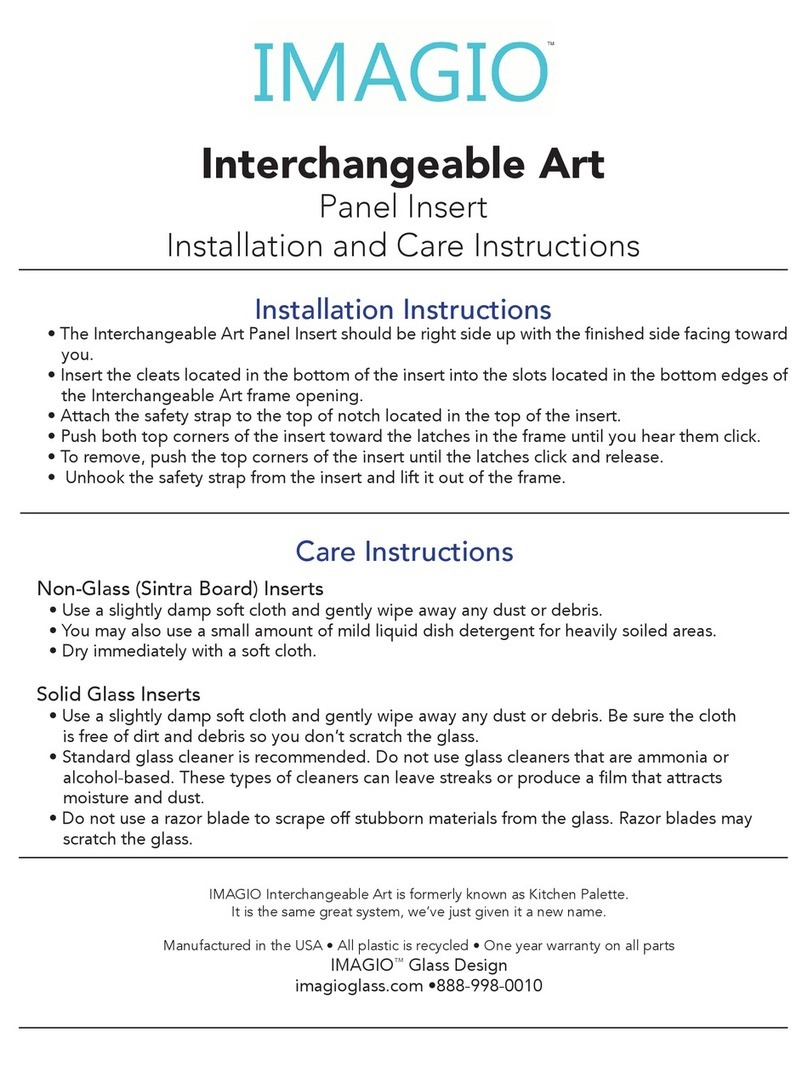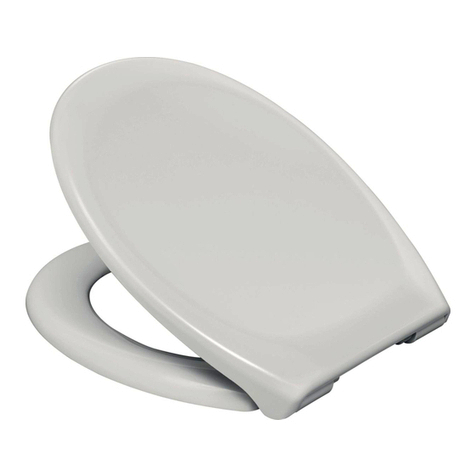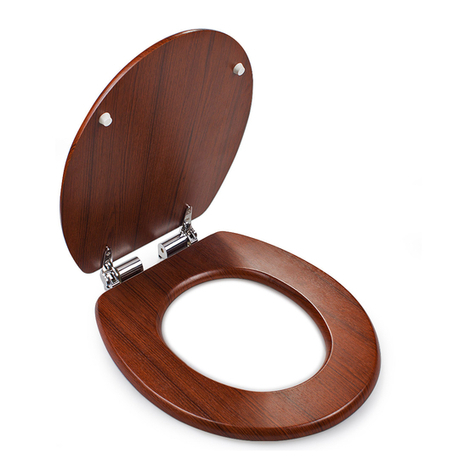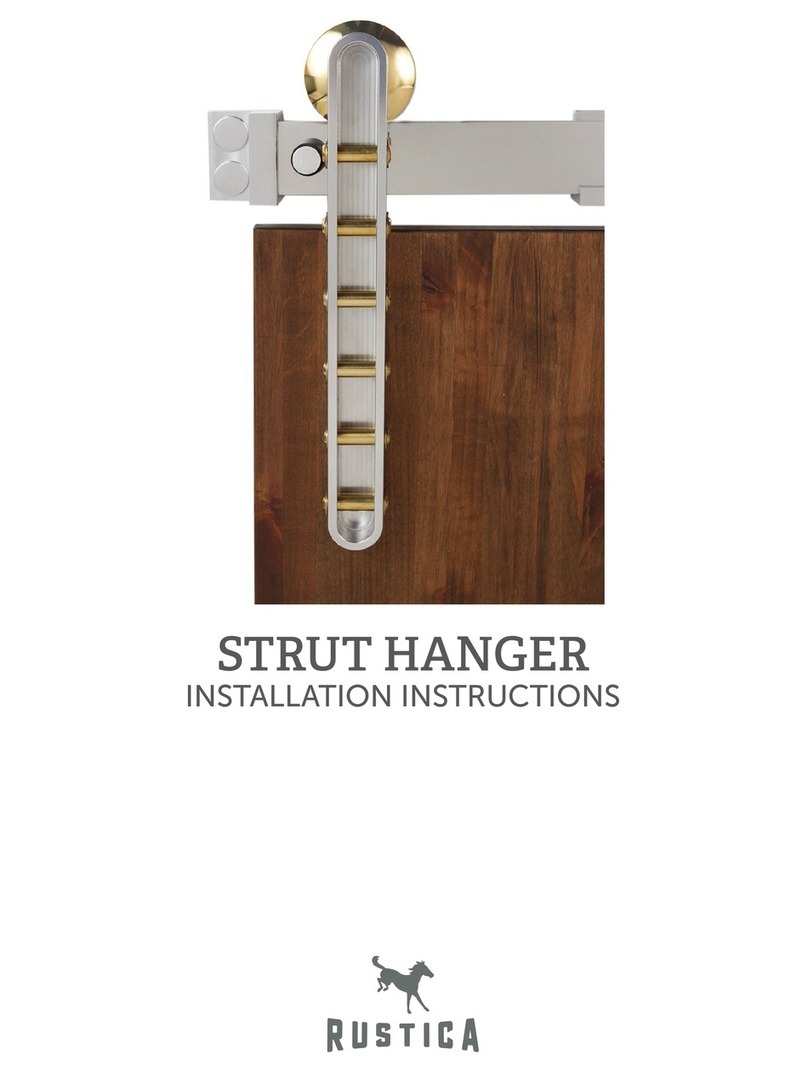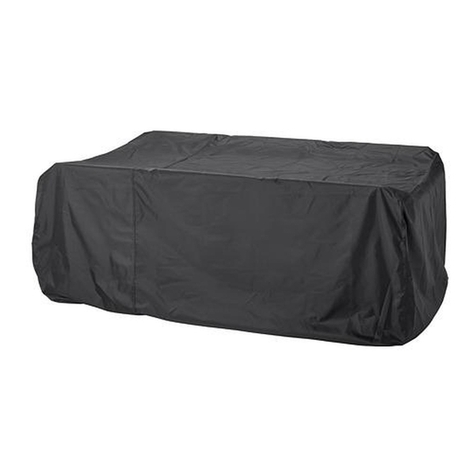Kentwood Revelation User manual


CONTENTS
Product Use & Installation Options .............. 3
Before Installation.......................................... 4
INSTALLER’S / CUSTOMER’S RESPONSIBILITY............................. 4
SITE PREPARATION........................................................................... 4
CLIMATE CONTROL........................................................................... 5
MOISTURE CONTENT........................................................................ 6
SUBFLOOR PREPARATION ............................................................... 6
RACKING............................................................................................ 6
EXPANSION SPACE ........................................................................... 7
Nail Down Installation .................................... 8
RECOMMENDED FASTENERS & Nailing SCHEDULE ...................... 8
SERPENTINE GLUE-ASSIST .............................................................. 9
INSTALLATION................................................................................... 9
Glue Down Installation................................. 11
After Installation ......................................... 13
On completion of the installation ................................................... 13
24 hours after installation .............................................................. 13

3
INSTALLATION INSTRUCTIONS
Revelation | 06.2018
Part 1.
PRODUCT USE & INSTALLATION OPTIONS
This floor may be installed:
• On, above or below grade
• With glue down or nail down installation
• Over OSB, plywood or concrete subfloor
This floor may be installed over radiant heat if:
• The specific product style is approved for use over radiant heat (certain species and styles
• Are not approved)
• The floor is installed with glue down installation
• The system is an hydronic (hot water) heat system, or an electric system specifically designed for use with
hardwood flooring (must be approved by Kentwood Technical Services)
• The system has an exterior thermostat in addition to interior controls
• The installation conforms to the conditions specified in the Special Instructions for Installation over Radiant
Heat (available from your kentwoodfloors.com)
• If approved heat sensors are not installed under the floor in accordance with the Kentwood ‘Special
Instructions for Installations Over Radiant Heat Systems, Kentwood accepts no responsibility for any damage
to the floor caused by a radiant heat system. Such damage is not covered by the product warranty.
KENTWOOD accepts no responsibility for any damage to the floor caused by a radiant heat
system. Such damage is not covered by the product warranty.
This floor should NOT be installed in a bathroom, laundry room or any area that may experience
elevated humidity (sauna, sunroom, etc) Such use will void the product warranty.
KENTWOOD floors are for indoor use only, in residential or light commercial applications. The use of a
certified installer is recommended for all installations.
For Technical Assistance in Canada, please call: 1-800-992-3163
For Technical Assistance in the USA, please call: 1-800-851-3841
or email techserv@metrofloors.com

4
INSTALLATION INSTRUCTIONS
Revelation | 06.2018
INSTALLER’S / CUSTOMER’S RESPONSIBILITY
It is the responsibility of the installer and/or customer to ensure that the KENTWOOD product
meets or exceeds their expectations for visual appearance and manufacturing quality.
Because KENTWOOD floors are made from real wood, every piece of KENTWOOD flooring will
have a unique appearance, often with naturally-occurring variations in color, texture and grain
pattern. Showroom samples and photographic reproductions may not represent the full range of
color, texture and grain variations and milling tolerances which can occur in the product itself. It is
strongly recommended that, prior to commencing installation, the customer and installer open
several boxes of product and loose lay the boards on the floor. Examine the product carefully to
ensure that it meets the customer’s expectations for appearance, color and visual character and
quality before proceeding with the installation.
If the visual appearance or manufacturing quality of the product is deemed unacceptable, it
should not be installed. Flooring that has been installed will be deemed to have been inspected
and accepted by the installer and customer, even if the customer is not present at the time
of installation. Every piece of flooring should be inspected and if any piece does not meet
expectations of quality, it should not be installed.
It is the sole responsibility of the installer to ensure that the job site, subfloor and installation tools
and materials meet or exceed these instructions and any applicable industry standards. KENTWOOD
accepts no responsibility for problems arising from incorrect or improper site
preparation or installation procedures.
For further information on installation standards and guidelines, call
In Canada: 1-800-992-3163:
In the US: 1-800-851-3841
or email techserv@metrofloors.com
SITE PREPARATION
INSTALLATION IN NEWLY-CONSTRUCTED HOME
Installation of wood flooring is one of the last jobs of a new home construction. Prior to installing a
wood floor, the following conditions must be met:
• The building is completely enclosed with all outside doors and windows in place and securable, including a
door from an attached garage to house interior
• All concrete, masonry, plastering, drywall, texturing, painting, tiling and other wet work is complete and dry
basements must be dry, within recommended temperature and humidity ranges, with no standing water and
adequate cross-ventilation in accordance with NWFA guildlines
KENTWOOD floors are manufactured in
accordance with accepted industry practices
which permit a defect tolerance not to exceed 5%.
These defects may be the result of manufacturing
or naturally occurring characteristics of the
material. It is recommended that a minimum 5%
cutting or grading allowance be added to the total
square footage when calculating the quantity of
flooring required. Boards that are judged to be
defective should not be installed or should be
installed in an inconspicuous location where they
will not be noticeable (e.g. inside a closet).
Part 2.
BEFORE INSTALLATION
PRODUCT INSPECTION & SITE PREPARATION

5
INSTALLATION INSTRUCTIONS
Revelation | 06.2018
• Crawl spaces must be dry, with no standing water and adequate cross-ventilation in accordance with local
NWFA Guildlines. Exposed earth crawl spaces must also have a vapor retarder (ASTM D 1745 Standard)
installed to NWFA guidelines
• Gutters and downspouts are in place, directing water away from the building
• Landscaping is directing water away from the building
• HVAC systems are fully operational, enabling heat and humidity levels to be controlled and maintained
throughout the home, and have been operating for a minimum of 5 days prior to installation
• Subfloor is properly inspected and prepared for installation in accordance with these instructions
• If installing over radiant heat, ensure that the system is in full working order and has been fully tested and
running for a minimum of two weeks prior to installation. The system should be turned off for 24 hours prior
to installation in the install zone
INSTALLATION IN EXISTING HOME (RENOVATION)
Installation in an existing home must meet the same conditions as a new home. If part of a larger
remodeling project, ensure that all wet work (painting, wallpapering, texturing, etc.) is completed
and thoroughly dry before commencing flooring installation. In addition:
• Remove all furniture, artwork and other valuables from installation area
• Remove baseboards and moldings
• Undercut door casings and jambs (use a piece of the flooring as a depth gauge)
• Remove existing flooring, if necessary
• If installing over radiant heat, it is strongly recommended that a radiant heat technician be
• Consulted prior to installation to ensure that the heating system can be operated effectively at
• Temperatures acceptable to the wood flooring. The system should be turned off for 24 hours
• Prior to installation in the install zone
CLIMATE CONTROL
Conditions at the job site must be maintained with the temperature between 60 - 80OF (15 - 26OC) and
humidity at 30-50% before, during and after the installation.
In areas with extreme climate conditions it may
be necessary to use humidifiers or dehumidifiers
to ensure the humidity is kept within the
recommended range.
Flooring material should not be delivered to job site until these conditions have been met and maintained
for five days prior to installation.
Following installation, these conditions should be maintained at all times to ensure proper performance
of the floor. See Warranty for details.
Required interior conditions for hardwood flooring are temperature of 60 - 80OF (15 - 26OC) and relative
humidity of 30 to 50%. When these conditions have been established at the job site, material may
be delivered to the site. Do not deliver flooring to job site if climate conditions have not been met and
maintained as described above otherwise damage to product may result.
When flooring has been delivered to the job site, leave the boxes closed until ready to commence
the installation, and then open only as needed.
Part 2.
BEFORE INSTALLATION
PRODUCT INSPECTION & SITE PREPARATION

6
INSTALLATION INSTRUCTIONS
Revelation | 06.2018
MOISTURE CONTENT
All wood flooring must be tested for moisture content prior to installation to ensure moisture content
is within allowable limits. When ready to commence installation, open several boxes of product and test
and record moisture content of the flooring using a reliable and accurate moisture testing device. Wood
flooring should have a moisture content between 6 and 9 %.
SUBFLOOR PREPARATION
The installer is responsible for ensuring that the subfloor is suitable for the flooring application and
properly prepared for installation.
All subfloors must be flat, clean, dry, structurally sound, and free of squeaks and protruding fasteners.
The subfloor must be flat to within 3/16” over 10 feet, or 1/8” in 6 feet radius.
Plywood or OSB subfloors the minimum acceptable thickness of the subflooring will be determined by
the truss/joist spacing.
Truss/joist spacing.
(Measured on center)
Minimum acceptable thickness, 4’ x 8’ sheets
16” (406mm) or less • 5/8” (19/32”, 15.1mm) CD Exposure 1 Plywood or
• 23/32” Exposure 1 OSB
More than 16”, up to
19.2" (488mm)
• 3/4“ (23/32”, 18.3mm) T&G CD Exposure 1 Plywood, glued and
mechanically fastened, or
• 3/4“ (23/32”, 18.3mm) Exposure 1 OSB, glued and mechanically
fastened
More than 19.2”
(488mm) to a maximum
of 24” (610mm)
• 7/8” T&G CD Exposure 1 Plywood, glued and mechanically fastened, or
• 7/8” Exposure 1 OSB, glued and mechanically fastened or
• Two layers of subflooring
In addition to meeting or exceeding the minimum acceptable thickness requirement, the subfloor must
be secure to the joists, and free of squeaks and protruding fasteners. Subfloor moisture content must
not exceed 12%, and the variance in moisture content between the full thickness of the subfloor and the
flooring boards must not exceed 3 percentage points, based on a minimum of 20 tests per 1000sf.
Concrete subfloors must be dry, clean and free of non-compatible sealers, waxes, oil, paint, drywall
compound, or other bond-breaking substances. (Check for the presence of sealers by applying drops
of water to the slab. If the water beads up, there may be sealers or oils.) All slabs must be tested for
moisture content using test method ASTM F2170-11 or equivalent and must return a reading of 75%
relative humidity or less.
RACKING
Real wood flooring contains natural variations in color and grain pattern. In order to prevent color
clustering or repetitive grain patterns in the finished floor, it is recommended that boards be racked
(visually sorted) before installation to create a satisfactory and pleasing color arrangement. Immediately
prior to installation, unpack several cartons to get a sense of the range of color variation and arrange
the planks to achieve a satisfactory appearance.
Part 2.
BEFORE INSTALLATION
PRODUCT INSPECTION & SITE PREPARATION

7
INSTALLATION INSTRUCTIONS
Revelation | 06.2018
Real wood flooring contains natural variations in color and grain pattern. In order to prevent color
clustering or repetitive grain patterns in the finished floor, it is recommended that boards be racked
(visually sorted) before installation to create a satisfactory and pleasing color arrangement. Immediately
prior to installation, unpack several cartons to get a sense of the range of color variation and arrange
the planks to achieve a satisfactory appearance.
When racking, distribute lengths where possible. Avoid ‘H’ patterns, stair-steps and other discernible
patterns in adjacent rows. When racking, a general rule is to stagger the end joints by a minimum of
double the board width (e.g. for boards 5” / 125mm wide stagger joints a minimum of 10” / 250mm).
For products 3” to 5” (8 – 13cm) in width do not use boards of less than 6” (15cm) in length.
For products over 5” (13cm) in width do not use boards of less than 12” (30cm) in length.
When racking, inspect all boards for visible manufacturing defects. Boards with manufacturing defects in
excess of industry standards (5% of total quantity) may be replaced by the dealer under the terms of the
product warranty. Once installed, boards will be considered to have been accepted by the customer and
will not be eligible for replacement. (See Warranty for details.)
EXPANSION SPACE
Wood flooring will expand and contract with changes in ambient temperature and humidity. To
allow for this, during installation leave a 1/2” expansion space around the entire perimeter of the
floor between the flooring and the walls. Also leave expansion space where the flooring will meet
any vertical obstruction, such as stairs, pipes, door sills, tiles, cabinets etc.
Part 2.
BEFORE INSTALLATION
PRODUCT INSPECTION & SITE PREPARATION
Wide-Plank flooring has become increasingly
popular in recent years and many of our
KENTWOOD products feature wide plank designs.
Most of these can be successfully installed using
the nail-down method, however with some of the
challenges installers face with today’s subfloors
in the areas of thickness and type, special
consideration should be given to using the full-
spread glue method in order reduce the potential
for noise related issues. If you have any concerns
in this area please contact one of our specialists
through techserv@metrofloors.com

8
INSTALLATION INSTRUCTIONS
Revelation | 06.2018
Nail down installation requires three different nailing systems:
• A pneumatic or manual blind-nailer
• A pneumatic finish nailer
• A brad nailer for top-nailing
FASTENER GAUGE SIZE NAIL SPACING DISTANCE FROM
END
Staple 15½" 2" 4" - 6" 1" - 2"
Cleat 16 2" 4" - 6" 1" - 2"
RECOMMENDED FASTENERS & NAILING SCHEDULE
REVELATION 20mm (3/4” thick)
COMMENTS: Requires glued end joints and glue assist.
Installation of this product with nail down installation requires glue assist and gluing of butt joints. See notes
below. For more information on glue assist techniques, contact techserv@metrofloors.com.
Part 3B.
NAIL DOWN INSTALLATION
WIDE PLANK (>7”/180MM)
When installing hardwood floors wider than 7”
using the nail-down installation method, glue-assist
applied to the backs of the boards is required in
addition to end-gluing the butt-joints.
During installation of flooring pieces, push or gently
tap boards flush to the previous row. To prevent
damage to the finish, avoid tapping the face of
the board with a rubber mallet. Use of tapping
block is recommended to avoid splintering, and
edge damage. Tap against the tongue; tapping the
groove may damage the edge.
When installing these products using the nail-
down installation method, always follow the
recommendations for fastener selection and the
nailing schedule for that specific product. Fastener
spacing, gauge, length and type are critical, and
it is the obligation of the installer to meet these
requirements. Prior to beginning installation,
installers are advised to test-nail a couple of
pieces of flooring to ensure the nailer/fastener
combination is providing a satisfactory result, and
to ensure issues such as “dimpling” and “edge-
splintering” are not occurring.
Our nail-down installation guidelines are intended to offer the best “Industry Practices” as they are known
to be at this point in time. Adhering to them will help minimize (but may not eliminate) the occurrence of
objectionable noises. The National Wood Flooring Association (NWFA) acknowledges that some minor
noise associated with hardwood flooring should be considered normal.

9
INSTALLATION INSTRUCTIONS
Revelation | 06.2018
Part 3B.
NAIL DOWN INSTALLATION
WIDE PLANK (>7”/180MM)
For boards widths wider than 7“ the installer is also required to glue butt joints with non-crystallizing
floating floor adhesive applied to the bottom of the groove.
Failure to follow instructions for ‘glue assist’ or ‘glued butt joints’ may result in squeaking and/or other
objectionable floor noise. Such noise is not the result of a product defect and is not covered by the
product warranty. Some noise can be expected on all nail down installations
Keep in mind when using the glue-assist method, you will no longer be able to install a Class II perm-rated
vapor retarder like AquabarB between the hardwood and the subfloor. If you have concerns regarding
vapor migration from below, you may wish to consider applying a roll-on liquid moisture barrier applied
to subfloor prior to installation. If you wish additional information in this area please contact one of our
specialists through techserv@metrofloors.com
INSTALLATION
Check nail gun to make sure the depth is set for the appropriate thickness of the flooring. Ensure the
nailer is not scratching the floor surface.
Test nail a piece of scrap to make sure the nailer is correctly set up, and that the fasteners are being
properly positioned and set.
Ensure plywood subfloor is suitable and properly prepared. Verify moisture content of both subfloor and
flooring is within allowable limits before commencing installation. Open several packages of flooring and
rack and inspect boards. (See Racking, above.)
Apply adhesive in the serpentine pattern as previously outlined as well as add glue to the butt-joints along
to the bottom of the groove, and set the first row in place. If required, snap a chalk guideline to act as
SERPENTINE GLUE-ASSIST
The correct method for serpentine glue-assist is to apply a bead of elastomeric adhesive directly to the
back of the individual boards to be installed. Do not apply the bead of adhesive directly to the subfloor.
The subfloor should be thoroughly vacuumed and free of debris to ensure proper adhesion of the
elastomeric adhesive to the subfloor.
No more then 10” peak to peak
No more then 1” from
the edges and ends
Correct Nail Depth
Incorrect Nail Depth | Protruding
Incorrect Nail Depth | Too Deep

Because some minor collateral damage may
occur during the installation of a prefinished floor,
minor touch-ups with the use of the appropriate
colored putty, marker-stick or filler is considered
acceptable industry practice, provided the these
repairs pass inspection from a standing position.
Part 3B.
NAIL DOWN INSTALLATION
WIDE PLANK (>7”/180MM)
Using glue-assist and butt-joint glue procedures set the second row in place. Use offcuts if lengths
are suitable and stagger end joints as required (see above). Blind- nail along the tongue as before or, if
working space permits, use the nail gun.
Continue with subsequent rows sing glue-assist and butt-joint glue procedures. To avoid a repetitive or
predictable board patterns, cut some boards to random lengths to begin rows. Open new packages
several at a time and rack and inspect boards as described above. Ensure 1/2” expansion space is
maintained at all perimeter walls and other vertical obstacles. Maintain nailing schedule and keep butt
joints staggered as described above.
In the last couple of rows, there may not be space to use the nail gun, so revert to using the finish nailer
with glue-assist and butt-joint glue procedures as before, blind nailing through the tongue. For the final
row, measure the gap to the wall, allowing expansion space, and rip a row of boards to the required
width. Top nail the final row into place using brads or finishing nails placed 1/4” in from the edge. Install
moldings and transitions as required.
10
INSTALLATION INSTRUCTIONS
Revelation | 06.2018
It is a common practice among some installers to
use a ‘full spread glue down’ on the first and last
few rows of a nail down installation in order to
avoid top nailing. This practice is not recommended
by Kentwood for any nail down installation. Any use
of full spread glue down on first and/or last rows
within a nail down installation will automatically void
the product warranty.
a guide. If starting the installation against a wall, place boards with the groove side facing the wall and
remember to allow expansion space.
Top nail along the groove edge with the brad nailer using minimum 18g 1½” fasteners set 10 to
12” apart, with a fastener 1 to 3” from each end of each board. Keep the nailer perpendicular to the
direction of the flooring and set nails no less 1/4” in from the edge of the board.
Using a pneumatic finish nailer, blind nail along the tongue edge at a 45° angle. Follow the nailing schedule
specified above, spacing the recommended fasteners as indicated. Ensure a fastener is placed as
indicated near the end of each board.
At the end of the row, cut a board to fit, allowing 1/2” expansion space.

11
INSTALLATION INSTRUCTIONS
Revelation | 06.2018
Glue down installation is the recommended method for all wide-plank floors. Should is recommended to
be we recommend that it only be performed by professional wood flooring installers.
For installations over radiant heat, product & installation procedure must also conform to conditions
listed in ‘product use’ above.
Reminder For Installations Over Radiant Heat
Prior to flooring installation, ensure that the radiant
heat system is in full working order and has been
fully tested and running for a minimum of two
weeks prior to installation. The system should be
turned off for 24 hours prior to installation in the
install zone.
During installation of flooring pieces, push or gently
tap boards flush to the previous row. To prevent
damage to the finish, avoid tapping the face of the
board with a rubber mallet. Use of tapping block
is recommended to avoid splintering, and edge
damage.
subfloor and flooring is within allowable limits before commencing installation.
Select the starting point for the installation and snap a chalk line and / or install a guide strip to ensure
the first row of flooring is installed perfectly straight and, if relevant, parallel to starting wall, cabinetry,
tile etc.
Use a moisture-cured urethane adhesive specially formulated for wood flooring installation. KENTWOOD
recommends Pro Series 3089 - Urethane adhesive. For trowel selection, adhesive application and all
other aspects of adhesive usage, follow the adhesive manufacturer’s instructions.
Open several packages of flooring and rack and inspect boards. (See Racking, above.)
Apply adhesive evenly to the subfloor and set first row of boards in place along the chalk line or guide
strip with the groove facing outwards, towards the installer.
Leave 1/2” expansion space between the end of the first board and the wall. At the end of the row, cut
a board to fit, ensuring board length is not less than minimum specified. Allow 1/2” expansion space to
end wall. If desired, use offcut to begin next row.
Set subsequent rows working away from starting point. When installing new boards, avoid pushing them
into place across the subfloor as this may unevenly redistribute the adhesive. Instead, hold the new
board above the subfloor at an angle, engage the tongue into groove joint, then press the board directly
down onto the subfloor. Ensure no glue is forced into tongue & groove joints during installation as this
may affect the fit of the joint. Avoid getting adhesive on the flooring surface, and clean up any excess
glue immediately. Allowing the adhesive to dry on the surface of the board may permanently the finish. If
adhesive has been allowed to dry on the floor surface attempted use of solvents or adhesive cleaners
may also damage the floor’s finish. DO NOT Use any masking tape on the floor. Use of a ratchet clamp
systems is recommended.
Continue with subsequent rows. To avoid a repetitive or predictable board pattern, cut some boards
to random lengths to begin rows. Open new packages several at a time and rack and inspect boards
as described above. Use offcuts if lengths are suitable and stagger end joints as required (see above).
Ensure 1/2” expansion space is maintained at all perimeter walls and other vertical obstructions.
Complete the installation to the far wall. For final row, rip boards to required width (allowing 1/2”
expansion space at far wall). Remove the guide strip from the starter row and complete the last ten
rows back to the starter wall.
Part 4B.
GLUE DOWN INSTALLATION
NATURAL OILED PRODUCTS

Because some minor collateral damage may
occur during the installation of a prefinished floor,
minor touch-ups with the use of the appropriate
colored putty, marker-stick or filler is considered
acceptable industry practice, provided the these
repairs pass inspection from a standing position.
12
INSTALLATION INSTRUCTIONS
Revelation | 06.2018
Part 4B.
GLUE DOWN INSTALLATION
NATURAL OILED PRODUCTS
When installation is complete, install moldings and transitions as required.
Wait 24 hours or until the adhesive has fully cured before moving furniture or appliances onto floor or
before allowing heavy foot traffic. Wait 24 hours before applying a floor protection membrane.
If the flooring was installed over a radiant heating system, wait 24 hours after installation or until the
adhesive has fully cured before turning the system back on. Bring the temperature of the system up
gradually, in 5OF (2OC) increments per day. Never allow the surface temperature of the floor to exceed
80OF (26OC) and avoid dramatic temperature changes; always adjust the system gradually in 5OF (2OC)
increments per day. It is recommended that a dedicated quick recovery thermostat be installed to allow
the temperature of the radiant heating system to be accurately controlled.

13
INSTALLATION INSTRUCTIONS
Revelation | 06.2018
Part 6C.
AFTER INSTALLATION
HARD WAX PRODUCTS
ON COMPLETION OF THE INSTALLATION
• Inspect the floor from a standing position in non-reflected light.
• Sweep or vacuum the floor.
• DO NOT WASH THE FLOOR WITH ANY LIQUID FOR AT LEAST 2 WEEKS AFTER INSTALLATION IS
COMPLETE.
• 2 weeks after installation the floor may be cleaned using the OSMO wash and care cleanser with a
microfiber mop.
• DO NOT use steam assisted cleaning mops to clean the floor; they will cause damage to the floor and void
the product warranty.
• Perform a visual inspection of the installation with the homeowner or site supervisor.
• Ensure the homeowner or site supervisor is cognizant of the need to maintain heat and humidity at the
required levels at all times
• Ensure the homeowner or site supervisor has been given a copy of the Kentwood care & maintenance
guidelines (available online at kentwoodfloors.com)
• Complete the installation record form for future reference
If the floor is not being put into use immediately, the use of a floor protection membrane is strongly
recommended. Use a material with a Perm Class 3 vapor permeance rating to avoid trapping moisture/
vapor on or within the floor. When using floor protection, be sure to:
• Cover the entire floor to avoid exposing a partial area to sunlight causing an uneven color change
• Overlap the seams of the membrane and tape them to each other. Never tape the membrane directly to the
floor.
• Run membrane to the perimeter walls and tape to the base or shoe mouldings using low adhesion masking
tape.
24 HOURS AFTER INSTALLATION
• Install a floor protection membrane where appropriate (see above)
• If the flooring was installed over a radiant heating system, bring the temperature of the system up gradually,
in 5OF (2OC) increments per day. NWFA recommends that an outside thermostat be installed to prevent
sudden temperature swings in the floor assembly. Never allow the surface temperature of the floor to exceed
82OF (28OC) and avoid dramatic temperature changes; always adjust the system gradually in 5OF (2OC)
increments per day. It is recommended that a dedicated thermostat be installed to allow the temperature of
the radiant heating system to be accurately controlled.
Table of contents

